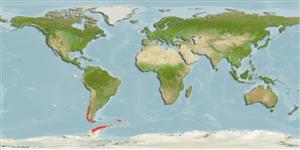Hexacorallia |
Actiniaria |
Preactiidae
Environment: milieu / climate zone / depth range / distribution range
Ecology
Sessile; depth range 10 - 610 m (Ref. 87801). Polar; 46°S - 74°S, 77°W - 35°W
Southeast Pacific and Antarctic Atlantic.
Length at first maturity / Size / Weight / Age
Maturity: Lm ? range ? - ? cm
This is a benthic mobile species found on primnoid gorgonians at depths of 10 to 610 m. It has a mouth capable of opening very wide, allowing it to prey on octocorals (Ref. 87801). Solitary (Ref. 2377).
Life cycle and mating behavior
Maturity | Reproduction | Spawning | Eggs | Fecundity | Larvae
Members of the class Anthozoa are either gonochoric or hermaphroditic. Mature gametes are shed into the coelenteron and spawned through the mouth. Life cycle: The zygote develops into a planktonic planula larva. Metamorphosis begins with early morphogenesis of tentacles, septa and pharynx before larval settlement on the aboral end.
Southern Ocean Mollusc Database (SOMBASE) 2011 British Antarctic Survey, SOMBASE. Accessed through GBIF data portal, http://data.gbif.org/datasets/resource/66, 2011-07-15. (Ref. 87340)
IUCN Red List Status
(Ref. 130435: Version 2025-1)
CITES status (Ref. 108899)
Not Evaluated
Not Evaluated
Threat to humans
Human uses
| FishSource |
Tools
More information
Population dynamicsGrowth
Max. ages / sizes
Length-weight rel.
Length-length rel.
Length-frequencies
Mass conversion
Abundance
Life cycleReproductionMaturityFecunditySpawningEggsEgg developmentLarvae PhysiologyOxygen consumption
Human RelatedStamps, coins, misc.
Internet sources
Estimates based on models
Preferred temperature
(Ref.
115969): 0.5 - 9.8, mean 7.1 (based on 46 cells).
Price category
Unknown.
